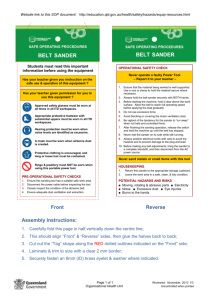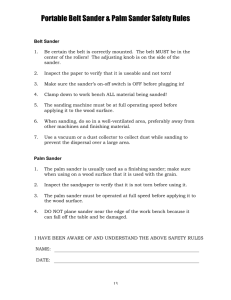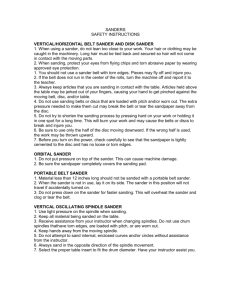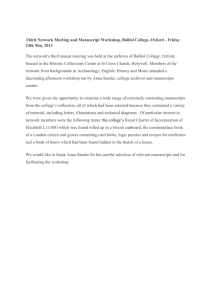Floor Sanders
advertisement
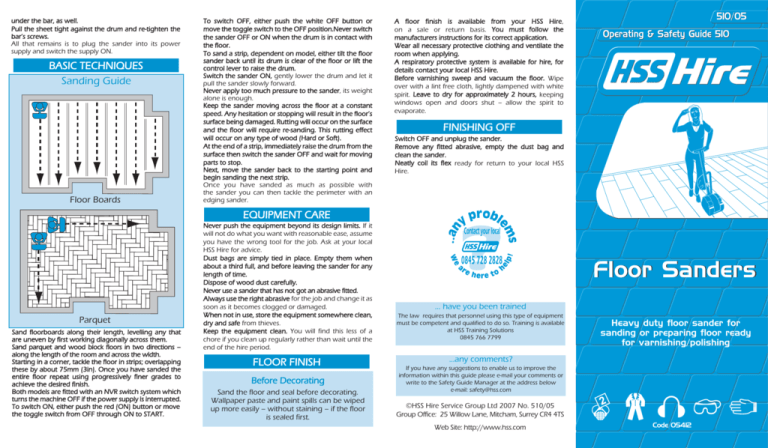
under the bar, as well. Pull the sheet tight against the drum and re-tighten the bar’s screws. All that remains is to plug the sander into its power supply and switch the supply ON. BASIC TECHNIQUES Sanding Guide Floor Boards To switch OFF, either push the white OFF button or move the toggle switch to the OFF position.Never switch the sander OFF or ON when the drum is in contact with the floor. To sand a strip, dependent on model, either tilt the floor sander back until its drum is clear of the floor or lift the control lever to raise the drum. Switch the sander ON, gently lower the drum and let it pull the sander slowly forward. Never apply too much pressure to the sander, its weight alone is enough. Keep the sander moving across the floor at a constant speed. Any hesitation or stopping will result in the floor’s surface being damaged. Rutting will occur on the surface and the floor will require re-sanding. This rutting effect will occur on any type of wood (Hard or Soft). At the end of a strip, immediately raise the drum from the surface then switch the sander OFF and wait for moving parts to stop. Next, move the sander back to the starting point and begin sanding the next strip. Once you have sanded as much as possible with the sander you can then tackle the perimeter with an edging sander. A floor finish is available from your HSS Hire , on a sale or return basis. You must follow the manufacturers instructions for its correct application. Wear all necessary protective clothing and ventilate the room when applying. A respiratory protective system is available for hire, for details contact your local HSS Hire. Before varnishing sweep and vacuum the floor. Wipe over with a lint free cloth, lightly dampened with white spirit. Leave to dry for approximately 2 hours, keeping windows open and doors shut – allow the spirit to evaporate. 510/05 Operating & Safety Guide 510 FINISHING OFF Switch OFF and unplug the sander. Remove any fitted abrasive, empty the dust bag and clean the sander. Neatly coil its flex ready for return to your local HSS Hire. EQUIPMENT CARE Parquet Sand floorboards along their length, levelling any that are uneven by first working diagonally across them. Sand parquet and wood block floors in two directions – along the length of the room and across the width. Starting in a corner, tackle the floor in strips; overlapping these by about 75mm (3in). Once you have sanded the entire floor repeat using progressively finer grades to achieve the desired finish. Both models are fitted with an NVR switch system which turns the machine OFF if the power supply is interrupted. To switch ON, either push the red (ON) button or move the toggle switch from OFF through ON to START. Never push the equipment beyond its design limits. If it will not do what you want with reasonable ease, assume you have the wrong tool for the job. Ask at your local HSS Hire for advice. Dust bags are simply tied in place. Empty them when about a third full, and before leaving the sander for any length of time. Dispose of wood dust carefully. Never use a sander that has not got an abrasive fitted. Always use the right abrasive for the job and change it as soon as it becomes clogged or damaged. When not in use, store the equipment somewhere clean, dry and safe from thieves. Keep the equipment clean. You will find this less of a chore if you clean up regularly rather than wait until the end of the hire period. FLOOR FINISH Before Decorating Sand the floor and seal before decorating. Wallpaper paste and paint spills can be wiped up more easily – without staining – if the floor is sealed first. Floor Sanders ... have you been trained The law requires that personnel using this type of equipment must be competent and qualified to do so. Training is available at HSS Training Solutions 0845 766 7799 Heavy duty floor sander for sanding or preparing floor ready for varnishing/polishing …any comments? If you have any suggestions to enable us to improve the information within this guide please e-mail your comments or write to the Safety Guide Manager at the address below e-mail: safety@hss.com ©HSS Hire Service Group Ltd 2007 No. 510/05 Group Office: 25 Willow Lane, Mitcham, Surrey CR4 4TS Web Site: http://www.hss.com Code 05412 GENERAL SAFETY ELECTRICAL SAFETY For advice on the safety and suitability of this equipment contact your local HSS Hire. This equipment should be used by an able bodied, competent adult who has read and understood these instructions. Anyone with either a temporary or permanent disability, should seek expert advice before using it. Keep children, animals and bystanders away from the work area. Never use this equipment if you are ill, feeling tired, or under the influence of alcohol or drugs. Most HSS equipment is designed to plug straight into a standard 230V 13A power socket. However, 110V models (with a round yellow plug) must be powered only from the mains via a suitable transformer. Extension leads should be fully unwound and loosely coiled away from the equipment. Never run them through water, over sharp edges, or where they could trip someone. Using electrical equipment in very damp or wet conditions can be dangerous. To reduce the risk of electric shock, use a suitable RCD (Residual Current Device) available from your local HSS Hire. If the equipment fails, or if its power supply cable or plug gets damaged, return it. Never try to repair it yourself. Ensure the sander and power socket are switched OFF before plugging into the power supply. Safety goggles must be worn by everyone in the work area. Some materials contain substances which, when sanded, can be harmful to health. A suitable mask must be worn when using this equipment. This equipment generates potentially harmful noise levels. To comply with Health and Safety at Work regulations, ear defenders must be worn by everyone in the vicinity. Wear practical protective clothing, footwear and gloves. Avoid loose garments and jewellery that could catch in moving parts. Tie back long hair. This type of floor sander MUST NOT be used on Parquet or overlay flooring which has a veneer finish. Veneer is only a couple of millimetres thick and should be sanded with a light orbital type machine. Never carry or pull the machine by its power supply cable. Check the equipment before use, if it shows signs of damage or excessive wear, return it. GETTING STARTED Ensure the floor is free from nails and screws. If these cannot be removed, drive them well below the surface. If the machines handle assembly has been removed for ease of transport, re-fit (see individual illustration). The EZ8 model is held in place by the side clip, whereas the HT8 model is held in place by tightening the T bar. It is extremely important that the handle assembly is correctly and securely fitted. HT8 Floorsander EZ8 Floorsander ON/OFF Switch RAISE Drum Control Lever ON OFF START-ON-OFF LOWER Dust Bag 2 Dust Bag 1 Socket 3 Front Flap Front Flap 'T' Bar Side Clip 4 Fitting the Abrasive Holding Screws Fire Warning WOOD DUST IS EXPLOSIVE. Never store wood dust it can be dangerous. Empty dust-bags when they are approximately 1/3 full and before leaving or storing the machine. Never tip wood dust into a fire or incinerator it may explode. Never leave it packed in a dust-bag or similar container it can ignite spontaneously. To dispose of it safely, mix it with general rubbish. Ensure the work area is well ventilated and free from anything that could ignite wood dust. Always switch OFF and unplug the machine before making any adjustments to it. COSHH Information sheets are available from your local HSS Hire. Gripper Bar Next, connect the supply cable from the handle assembly to the power unit by inserting the plug and turning clockwise. Fit the sander with the appropriate abrasive. In general, start with a medium grade, then work through to a fine grade until the desired finish is achieved. Tilt the machine back. lift the front flap and loosen the screws on the sanding drum’s gripper bar. Check the bar to ensure it is the correct way round, as the floor surface will be damaged if the bar is fitted incorrectly. When correctly fitted, the holes in the bar where the holding screws are located should have a countersunk Socket edge to allow the holding screw to be recessed. If in doubt do not use the sander, contact your local HSS Hire for advice. Push one end of the sanding sheet under the bar and rotate the drum by hand until you can fit the other end
